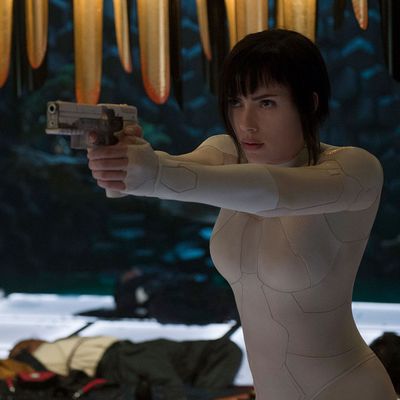
For all the liberties the new Ghost in the Shell takes with its source material, it’s more invested in that title, specifically the “ghost” soul of its cyborg protagonist, than any of its predecessors in the long-running anime and manga franchise. That’s not to say that it does anything dramatically interesting about that soul, or asks many challenging questions about what it’s like for a person to persist, divorced from their original body. But it is obsessed with idea that Major “Mira” (Scarlett Johansson) must unlock her true individuality to defeat the system, an extraordinarily American narrative shoddily grafted onto the original story like a black-market crab-claw arm. The body rejects it almost immediately.
The story still takes place in a future in which cybernetic enhancement has become the norm, and most humans have a port on their neck through which they can download and upload information. In this Ghost in the Shell, the Major has been rescued from an attack on a refugee boat, which apparently damaged her body so much that her brain was morally appropriate for experimentation. Government contractor Hanka Industries outfits her with Scarlett Johansson’s face and body — she’s the first of her kind, they tell us — and then immediately put her to work as a super-agent in Section 9, a defense division led by Aramaki (Takeshi Kitano) that’s as well-defined as a bi-monthly book club. Then the Major starts to have flashback “glitches,” and after “diving” into the drive of a hijacked geisha-bot, meets a shadowy figure named Kuze, who tells her not to trust Hanka Industries. Her bosses assign her and the team to track down and kill Kuze, which she dutifully does until the question of her past is no longer avoidable.
If Paramount just wanted to do a female-led cyberpunk Bourne Identity, probably nobody would have minded. But to associate a straightforward “Who am I?” action film with a franchise as philosophically noodly as Ghost in the Shell is disingenuous and pointless — you deny existing fans the actual post-self substance of the thing they like, and you alienate newcomers with a weird title and the obligatory skeleton of an existing franchise, which, when it’s not being explored, comes off as needlessly complicated. Why does a newcomer to Ghost in the Shell care about Section 9, or the idea of cyberbrains, if it’s not integral to the questions the film is asking? Why is this a story about robotics? Why is this Ghost in the Shell?
The answer to the last question is unfortunately obvious: It’s a means of lifting set pieces and conceptual designs without getting accused of copyright infringement. Whereas American comic-book adaptations pepper their films with nods to obscure characters and comic-only plotlines to stoke the emotional memory of their core fan base, Ghost in the Shell winks at things and moments — enhanced keyboard fingers, invisible fight scenes, detachable eyes, an adorable Basset hound — all ripped from their original context and compiled in what amounts to a look book. This is telling: The filmmakers think little of the emotional and intellectual connection fans already have with this property, and have put all their chips on the aesthetic. It’s exhausting to watch them curate what parts of the story’s Japanese origin are worth keeping and which can be discarded.
And what about Johansson herself, the center of the controversy surrounding this adaptation? She’s great — this is the kind of part she’s been circling around for years now, and you can see how important it is to her to sell the Major as a compelling figure worthy of a long-running American franchise. I’ve always found the idea that the Major must look Asian to be a little dubious in a story about self-erasure and what we culturally consider to be an “upgrade.” But what’s truly astounding (spoiler alert) is that this Ghost in the Shell explicitly states that the Major does indeed carry the brain of a Japanese woman in her Caucasian shell — not only a Japanese woman, but a Japanese revolutionary anarchist named Motoko Kusanagi who spent her pre-cyborg days writing pamphlets about how “technology is destroying the world.” We see her only briefly in a pixilated flashback; her hair is covering her face.
Why Hanka would choose such a liability as the foundation of their cyborg project is a mystery, but it hints at a fascinating alternate story about a Japanese robotics company placing Asian brains in indestructible Caucasian bodies to create a line of military superheroes. It would be about cultural erasure and appropriation, the cherry-picking of trendy Asian sensibilities and perceived efficiencies with western beauty standards and individualist ideals. Someone should make that movie. I think it might be relevant.

